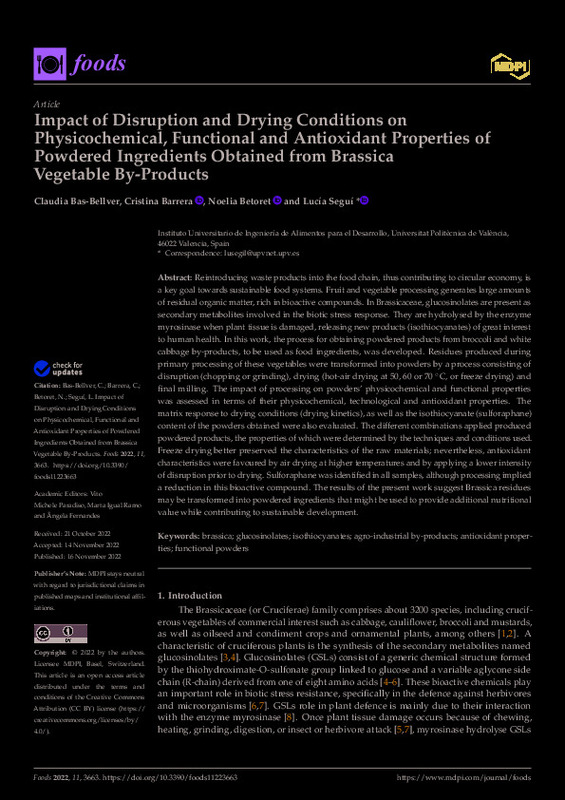JavaScript is disabled for your browser. Some features of this site may not work without it.
Buscar en RiuNet
Listar
Mi cuenta
Estadísticas
Ayuda RiuNet
Admin. UPV
Impact of Disruption and Drying Conditions on Physicochemical, Functional and Antioxidant Properties of Powdered Ingredients Obtained from Brassica Vegetable By-Products
Mostrar el registro sencillo del ítem
Ficheros en el ítem
| dc.contributor.author | Bas-Bellver, Claudia
|
es_ES |
| dc.contributor.author | Barrera Puigdollers, Cristina
|
es_ES |
| dc.contributor.author | Betoret Valls, Noelia
|
es_ES |
| dc.contributor.author | Seguí Gil, Lucía
|
es_ES |
| dc.date.accessioned | 2023-05-26T18:01:44Z | |
| dc.date.available | 2023-05-26T18:01:44Z | |
| dc.date.issued | 2022-11 | es_ES |
| dc.identifier.issn | 2304-8158 | es_ES |
| dc.identifier.uri | http://hdl.handle.net/10251/193628 | |
| dc.description.abstract | [EN] Reintroducing waste products into the food chain, thus contributing to circular economy, is a key goal towards sustainable food systems. Fruit and vegetable processing generates large amounts of residual organic matter, rich in bioactive compounds. In Brassicaceae, glucosinolates are present as secondary metabolites involved in the biotic stress response. They are hydrolysed by the enzyme myrosinase when plant tissue is damaged, releasing new products (isothiocyanates) of great interest to human health. In this work, the process for obtaining powdered products from broccoli and white cabbage by-products, to be used as food ingredients, was developed. Residues produced during primary processing of these vegetables were transformed into powders by a process consisting of disruption (chopping or grinding), drying (hot-air drying at 50, 60 or 70 degrees C, or freeze drying) and final milling. The impact of processing on powders' physicochemical and functional properties was assessed in terms of their physicochemical, technological and antioxidant properties. The matrix response to drying conditions (drying kinetics), as well as the isothiocyanate (sulforaphane) content of the powders obtained were also evaluated. The different combinations applied produced powdered products, the properties of which were determined by the techniques and conditions used. Freeze drying better preserved the characteristics of the raw materials; nevertheless, antioxidant characteristics were favoured by air drying at higher temperatures and by applying a lower intensity of disruption prior to drying. Sulforaphane was identified in all samples, although processing implied a reduction in this bioactive compound. The results of the present work suggest Brassica residues may be transformed into powdered ingredients that might be used to provide additional nutritional value while contributing to sustainable development. | es_ES |
| dc.description.sponsorship | This research was funded by the regional government of Valencia (Generalitat Valenciana) under the Rural Development Program 2014-2020 (Ayudas para la cooperacion en el marco del Programa de desarrollo rural de la Comunitat Valenciana 2014-2020. Experiencias innovadoras y sostenibles entre productores y centros de investigacion con cultivos adaptados al cambio climatico y producidos con modelos agroecologicos) and the Spanish Ministry of Agriculture, fisheries and food, under the European Agricultural Fund for Rural Development. Grant number: AGCOOP_A/2021/020. | es_ES |
| dc.language | Inglés | es_ES |
| dc.publisher | MDPI AG | es_ES |
| dc.relation.ispartof | Foods | es_ES |
| dc.rights | Reconocimiento (by) | es_ES |
| dc.subject | Brassica | es_ES |
| dc.subject | Glucosinolates | es_ES |
| dc.subject | Isothiocyanates | es_ES |
| dc.subject | Agro-industrial by-products | es_ES |
| dc.subject | Antioxidant properties | es_ES |
| dc.subject | Functional powders | es_ES |
| dc.subject.classification | TECNOLOGIA DE ALIMENTOS | es_ES |
| dc.title | Impact of Disruption and Drying Conditions on Physicochemical, Functional and Antioxidant Properties of Powdered Ingredients Obtained from Brassica Vegetable By-Products | es_ES |
| dc.type | Artículo | es_ES |
| dc.identifier.doi | 10.3390/foods11223663 | es_ES |
| dc.relation.projectID | info:eu-repo/grantAgreement/AVFGA//AGCOOP_A%2F2021%2F020//OBTENCIÓN DE PRODUCTORS EN POLVO A PARTIR DE LAS LÍNEAS DE CONFECCIÓN DE COL BLANCA PARA SU USO COMO INGREDIENTE FUNCIONAL SOSTENIBLE Y PARA LA GESTIÓN INTEGRADA DE PLANTAS ARVENSES/ | es_ES |
| dc.rights.accessRights | Abierto | es_ES |
| dc.contributor.affiliation | Universitat Politècnica de València. Escuela Técnica Superior de Ingeniería Agronómica y del Medio Natural - Escola Tècnica Superior d'Enginyeria Agronòmica i del Medi Natural | es_ES |
| dc.description.bibliographicCitation | Bas-Bellver, C.; Barrera Puigdollers, C.; Betoret Valls, N.; Seguí Gil, L. (2022). Impact of Disruption and Drying Conditions on Physicochemical, Functional and Antioxidant Properties of Powdered Ingredients Obtained from Brassica Vegetable By-Products. Foods. 11(22):1-19. https://doi.org/10.3390/foods11223663 | es_ES |
| dc.description.accrualMethod | S | es_ES |
| dc.relation.publisherversion | https://doi.org/10.3390/foods11223663 | es_ES |
| dc.description.upvformatpinicio | 1 | es_ES |
| dc.description.upvformatpfin | 19 | es_ES |
| dc.type.version | info:eu-repo/semantics/publishedVersion | es_ES |
| dc.description.volume | 11 | es_ES |
| dc.description.issue | 22 | es_ES |
| dc.identifier.pmid | 36429255 | es_ES |
| dc.identifier.pmcid | PMC9689784 | es_ES |
| dc.relation.pasarela | S\477813 | es_ES |
| dc.contributor.funder | AGENCIA VALENCIANA DE FOMENTO Y GARANTIA AGRARIA | es_ES |
| dc.subject.ods | 02.- Poner fin al hambre, conseguir la seguridad alimentaria y una mejor nutrición, y promover la agricultura sostenible | es_ES |
| dc.subject.ods | 03.- Garantizar una vida saludable y promover el bienestar para todos y todas en todas las edades | es_ES |
| dc.subject.ods | 12.- Garantizar las pautas de consumo y de producción sostenibles | es_ES |
| upv.costeAPC | 1638,34 | es_ES |








